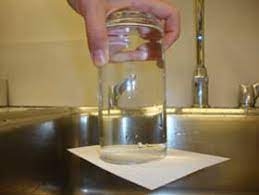
What do you need:
A glass, some water and a coaster.
What are you do:
- Fill the glass with milk or water. The outer bottom of the glass should be wet.
- Place it on a coaster.
- After a few minutes, lift the glass up.
- Wipe the bottom of the glass so that it is completely dry and then place it on the coaster.
What do you observe?
In A, the coaster rises with the glass. In B, the coaster does not rise with the glass.
Why does this happen?
The layer of water between the bottom of the glass and upper surface of the coaster leaves no room for air there. The coaster sticks to the glass when you raise it because the air pressure acting upwards on the bottom of the coaster makes it stick to glass. However, when you dry the outer bottom of the glass completely, the same coaster will not rise with the glass. As there is no water to seal the gap between the bottom of the glass and the coaster, air enters the gap, and the pressure of air on the bottom of the coaster is now compensated by the pressure from the air between the glass and the coaster. Hence the coaster fails to rise with the glass. Try the same experiment with the heavy coaster.
Picture Credit : Google



